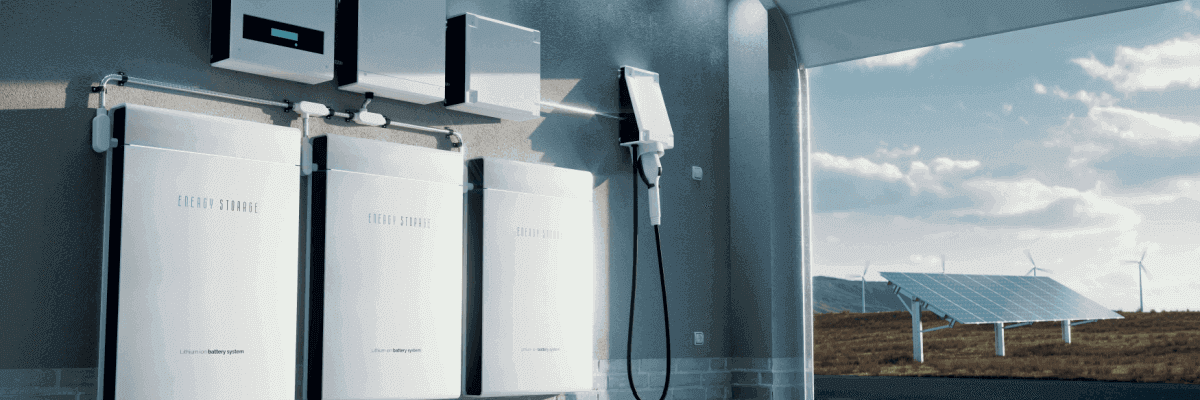KEY POINTS
- Solar batteries work in four key phases: energy capture, storage, chemical reactions and inverter conversion.
- There are three big benefits of a solar battery: energy independence, lower electricity bills and environmental impact.
- There are government incentives to help make solar panels and batteries more affordable.
As residential solar power continues to gain popularity, curiosity about the inner workings of solar batteries, which are the storage backbone of renewable energy, is also rising.
If you’ve ever wondered how solar-powered batteries work, you’ve come to the right place. In this Canstar Blue guide, we provide an explanation of their basic functions.
On this page:
How solar batteries work
Solar energy generation
When the sun’s out, solar panels transform sunlight into electricity as a direct current (DC) through a process called photovoltaic (PV) conversion. This electricity is then funneled into a solar inverter for conversion into an alternating current (AC) for home use.
Inverter conversion for storage
For AC-coupled battery systems, an independent battery inverter converts surplus AC electricity into DC electricity for storage in your solar battery for later use.
Conversely, a DC-coupled battery system typically shares a hybrid inverter with your solar system, handling all current conversions for consumption or storage. However, DC-coupled systems are directly connected to the DC output of your solar panels via a charge controller, avoiding the need for an AC to DC conversion.
The interchange of AC and DC currents is complex and depends on the type of inverter you choose.
Chemical reactions
Chemical reactions in the materials housed in the solar battery’s cells convert the residual energy into the form of chemical energy, storing it until needed.
Older solar batteries used lead-acid technology, which made them heavier and more difficult to maintain, with a weaker rate of absorption and lower ability to ‘absorb’ and ‘discharge’ electricity.
Most modern batteries typically use a type of lithium-ion technology that doesn’t have these downsides.
Inverter conversion for usage
When your household needs electricity and can’t obtain it directly from your solar panels as it’s generated, such as after dusk or on cloudy days, the stored energy in your battery gets converted back into AC electricity courtesy of your battery inverter or hybrid inverter.
This converted electricity can then power appliances and lights around the home, lessening your reliance on the electricity grid.
The benefits of solar batteries
There are three big benefits of adding a solar battery to your solar system.
Energy independence
Solar batteries empower their owners to be more self-sufficient instead of grid-reliant by storing surplus solar energy for use during peak demand periods or sunless stretches. Do take note that peak and off-peak periods only apply to customers on a time-of-use tariff.
Some solar batteries are even smart enough to top themselves up with electricity from the grid when electricity is at its cheapest.
Complete energy independence might even be possible for Aussies with an off-grid solar system.
Lower electricity bills
Solar batteries can help reduce your electricity bills by cutting back on grid reliance during peak times – which is when grid electricity is typically priced highest for residential users.
It’s important, though, to calculate what savings you may make on grid electricity and how that will balance the cost of purchasing a solar battery, so you know what your battery’s ‘payback period’ is.
If you’re on a plan with a solar feed-in tariff (FiT), surplus electricity from your solar system can also be exported to the grid in exchange for a bill credit. Solar FiTs differ from state-to-state and plan-to-plan, so it’s highly recommended you shop around for a competitive rate.
Keep in mind that you’ll need to have a net meter installed to both self-consume and export solar-derived electricity back to the grid.
Cost to add a battery to a solar system
Rising electricity costs make a good argument for adding a solar battery to your solar system.
The following table shows a range of solar batteries with an approximate installation cost, excluding the cost of hybrid inverters.
← Mobile/tablet users, scroll sideways to view full table →
| Battery system | Capacity | Approx. installed cost | Cost per kWh |
|---|---|---|---|
| Sigenergy | 7.8kWh | $6,200 | $790 |
| Sungrow | 12.8kWh | $7,000 | $550 |
| BYD | 13.8kWh | $7,400 | $540 |
| Enphase | 5kWh | $8,700 | $1,740 |
| SolarEdge | 9.7kWh | $10,200 | $1,050 |
| Tesla Powerwall 2 | 13.5kWh | $11,000 | $810 |
Source: Solar Quotes
There are government incentives and rebates designed to make solar energy and battery storage systems more affordable. This is coupled with the ability to export excess electricity that you don’t wish to store in a battery in return for a solar FiT, helping offset the cost of your battery.
Pros and cons of solar battery storage
Solar batteries allow homeowners to make the most of solar systems by stockpiling surplus solar electricity that they don’t use immediately, saving it for use at night or during power outages (if your solar battery has backup capabilities).
They’re pivotal in squeezing out the utmost efficiency from your solar energy setups, even when the sun isn’t shining.
And, as the Federal Department of Climate Change, Energy, the Environment and Water says, “recent design improvements and price drops in lithium-ion batteries have made solar storage more viable than ever before”.
However, there are pros and cons to consider when looking at purchasing a solar battery.
← Mobile/tablet users, scroll sideways to view full table →
| Solar battery | |
|---|---|
| Pros | Cons |
| Maximises solar potential | Larger upfront cost |
| Essential circuits powered during blackouts | Longer payback period |
| Can take advantage of cheaper electricity from the grid during off-peak periods | Space requirements |
| Potential for building an off-grid solar system | The lifespan of solar batteries is generally shorter than solar panels |
Advertisement
Compare solar plans in your state
Here are some of the cheapest solar-specific deals from the retailers on our database. These costs are based on the Ausgrid network in Sydney but prices will vary depending on your circumstances. We show one product per retailer, listed in order of lowest price first. Annual price estimates assume general energy usage of 3900kWh/year for a residential customer on a single rate tariff. Price estimates exclude solar feed-in tariff credits. These are products from referral partners†. Our database may not cover all deals in your area, and please check retailer websites for up to date information. Here are some of the cheapest solar-specific deals from the retailers on our database. These costs are based on the Citipower network in Melbourne but prices will vary depending on your circumstances. We show one product per retailer, listed in order of lowest price first. Annual price estimates assume general energy usage of 4000kWh/year for a residential customer on a single rate tariff. Price estimates exclude solar feed-in tariff credits. These are products from referral partners†. Our database may not cover all deals in your area, and please check retailer websites for up to date information. Here are some of the cheapest solar-specific deals from the retailers on our database. These costs are based on the Energex network in Brisbane but prices will vary depending on your circumstances. We show one product per retailer, listed in order of lowest price first. Annual price estimates assume general energy usage of 4600kWh/year for a residential customer on a single rate tariff. Price estimates exclude solar feed-in tariff credits. These are products from referral partners†. Our database may not cover all deals in your area, and please check retailer websites for up to date information. Here are some of the cheapest solar-specific deals from the retailers on our database. These costs are based on SA Power network in Adelaide but prices will vary depending on your circumstances. We show one product per retailer, listed in order of lowest price first. Annual price estimates assume general energy usage of 4000kWh/year for a residential customer on a single rate tariff. Price estimates exclude solar feed-in tariff credits. These are products from referral partners†. Our database may not cover all deals in your area, and please check retailer websites for up to date information.
Why understand how solar batteries work?
Getting to know the inner workings of solar batteries is important if you want to achieve the full potential of your home solar energy system.
Solar batteries can take your solar system a step further away from reliance on traditional energy sources and a step closer to energy self-sufficiency.
A good understanding of how solar batteries work is also key to knowing what you’re paying for if you decide to add one to your solar system, and then keeping that battery in great working order.
This article doesn’t cover the full complexity of how solar batteries function, so there may be more reading you’re interested you can check out this 101 guide from Solar Quotes founder Finn Peacock.
Understanding solar batteries will help you research the best solar battery brand and size you might need for your energy needs. Once you’ve done that, we recommend speaking to a licensed solar installer to discuss which options would be best suited to your circumstances.
You can begin comparing solar panel installers by clicking on the Canstar Blue link below.
Original reporting by Christine Seib
Image Source: petrmalinak/Shutterstock.com




Share this article